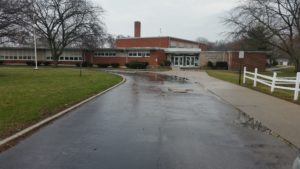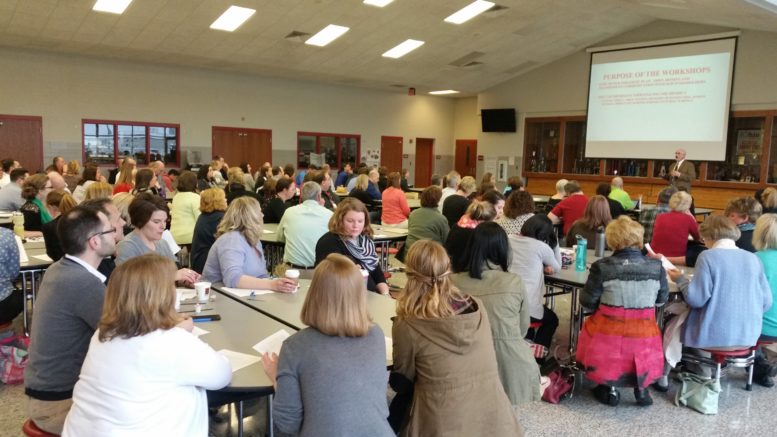By JAN LARSON McLAUGHLIN
BG Independent News
Bowling Green School District is at a crossroads. Though there are twists and turns with each route, the three basic directions lead to renovating, replacing or doing nothing with its school buildings.
One of the possible destinations ahead is consolidation of the three elementary schools in one new building.
During the first of many meetings expected to stretch over a year or more, Superintendent Francis Scruci explained to a crowd Monday evening that he doesn’t want to take one branch of the road, if local citizens want to go another direction.
“The process starts tonight,” Scruci said to the cafeteria full of parents, staff and citizens. “This is one of many conversations and we need to hear from you.”
The superintendent tried to summarize the 341-page school building survey received last month from the Ohio Facilities Construction Commission. The survey looked at 23 systems – such as heating, electrical or lighting – at each of the five school buildings and attached renovation and replacement dollars to them.
The survey found Conneaut Elementary to have the greatest needs, followed by Kenwood Elementary, the High School, Crim Elementary and then the Middle School. If the cost to renovate a school exceeds 66 percent of the cost to build a new school, then the commission considers it wise to build new, Scruci explained.

Conneaut Elementary School
Conneaut is the only school to exceed that two-thirds threshold, though Kenwood and the high school are close.
Though some school districts in the area have received significant financial help from the OFCC program, Bowling Green would not, Scruci said.
“We are viewed by the state as a wealthy school district,” he said, which was met by laughter from the crowd. The 118-square-mile district is mostly farmland which saw an increase in valuation, plus the district’s population includes “phantom” numbers of transient college students. Those two factors mean Bowling Green would get just 14 cents for every $1 spent on new construction.
Working with state money also comes with state strings, Scruci said, and those strings sometimes don’t allow districts to build as they wish. No state funding was used to build the Middle School, which meant the district could build larger classrooms to accommodate its needs, board member Ellen Scholl pointed out.
So the question then is – how much is the community willing to support? A new high school was estimated to cost between $36 and $42 million. One centralized elementary school was ballparked at $30 to $34 million.
“I don’t want to put anything on the ballot” that doesn’t have community support, Scruci said. “This is an exciting time. There are so many things and everything is on the table.”
However, one thing the school district won’t do is invest money in buildings now that may be bulldozed later. That was why the district is putting modular classrooms at Conneaut Elementary rather than building onto the school. And that’s why the high school won’t get air conditioning anytime soon – even though students turn into “melted pools of butter” on sweltering days, Scruci said.
“We are not going to put money into something that is going to be torn down,” he said. “If you want to tick a taxpayer off, that would be the way to do it.”
Scruci said one option for the district is to do nothing.
“We have to know what the community wants,” he said. “If this community says we don’t want to do anything to our buildings, then OK.”

Staff, parents and citizens listen at meeting.
But he cautioned that problems with the buildings won’t go away.
“If you kick the can down the road,” the costs will be greater to address later, he said.
The needs will grow as the buildings age, and as more children are stuffed into them. “We are bursting at the seams,” at all three elementaries, Scruci said. And the problems will worsen with the projected enrollment of 100 to 150 more students in the next 10 years.
Schools will be tested this coming year with a 15 percent increase in kindergarten enrollment due to a change in the cutoff deadline. That “bubble class” will pose challenges for the next 13 years for the district.
The community also needs to weigh the benefits of multiple elementaries, Scruci said.
“Neighborhood elementary schools were built at a time when kids were allowed to walk to school,” he said. The traffic jams at the elementaries at the end of the school day are evidence that only 11 percent of the elementaries’ 1,600 students are walkers.
Consolidation of the elementaries into one building would allow for more collaboration, which has been proven to lead to better student outcomes, according to Ann McCarty, executive director of teaching and learning for BG City Schools. A centralized building would also even out the number of students in each classroom.
“What you’ve got to think about is the education delivery to the students,” Scruci said.
If that is the direction chosen by the community, the district owns about 10 acres to the north of the high school/middle school. “We’ve got a lot of land out here,” he said.
One possibility mentioned for Crim Elementary if a centralized campus were to be created, was expanding the district’s preschool program, and moving the administration offices there. The administration offices are currently in rented space on Clough Street, costing $50,000 a year.

